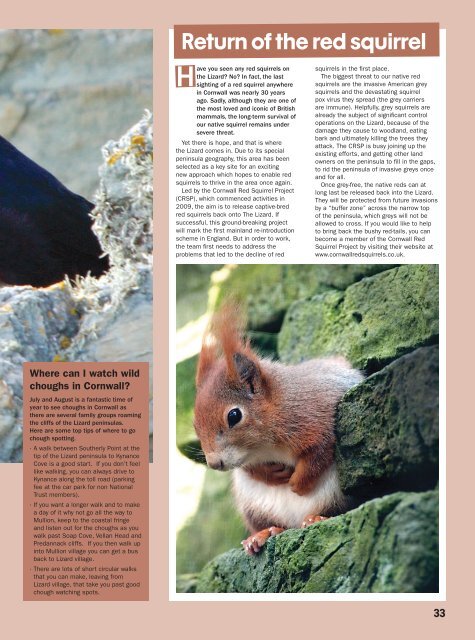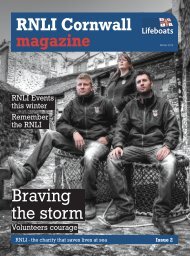Lizard Guide
Create successful ePaper yourself
Turn your PDF publications into a flip-book with our unique Google optimized e-Paper software.
Where can Iwatch wild<br />
choughs in Cornwall?<br />
July and August is afantastic time of<br />
year to see choughs in Cornwall as<br />
there are several family groups roaming<br />
the cliffs of the <strong>Lizard</strong> peninsulas.<br />
Here are some top tips of where to go<br />
chough spotting.<br />
·Awalk between Southerly Point at the<br />
tip of the <strong>Lizard</strong> peninsula to Kynance<br />
Cove is agood start. If you don’t feel<br />
like walking, you can always drive to<br />
Kynance along the toll road (parking<br />
fee at the car park for non National<br />
Trust members).<br />
·Ifyou want alonger walk and to make<br />
aday of it why not go all the way to<br />
Mullion, keep to the coastal fringe<br />
and listen out for the choughs as you<br />
walk past Soap Cove, Vellan Head and<br />
Predannack cliffs. If you then walk up<br />
into Mullion village you can get abus<br />
back to <strong>Lizard</strong> village.<br />
·There are lots of short circular walks<br />
that you can make, leaving from<br />
<strong>Lizard</strong> village, that take you past good<br />
chough watching spots.<br />
Returnofthe redsquirrel<br />
Have you seen any red squirrels on<br />
the <strong>Lizard</strong>? No? In fact, the last<br />
sighting of ared squirrel anywhere<br />
in Cornwall was nearly 30 years<br />
ago. Sadly,although they are one of<br />
the most loved and iconic of British<br />
mammals, the long-term survival of<br />
our native squirrel remains under<br />
severe threat.<br />
Yetthere is hope, and that is where<br />
the <strong>Lizard</strong> comes in. Due to its special<br />
peninsula geography, this area has been<br />
selected as akey site for an exciting<br />
new approach which hopes to enable red<br />
squirrels to thrive in the area once again.<br />
Led by the Cornwall Red Squirrel Project<br />
(CRSP), which commenced activities in<br />
2009, the aim is to release captive-bred<br />
red squirrels back onto The <strong>Lizard</strong>. If<br />
successful, this ground-breaking project<br />
will mark the first mainland re-introduction<br />
scheme in England. But in order to work,<br />
the team first needs to address the<br />
problems that led to the decline of red<br />
squirrels in the first place.<br />
The biggest threat to our native red<br />
squirrels are the invasive American grey<br />
squirrels and the devastating squirrel<br />
pox virus they spread (the grey carriers<br />
are immune). Helpfully, grey squirrels are<br />
already the subject of significant control<br />
operations on the <strong>Lizard</strong>, because of the<br />
damage they cause to woodland, eating<br />
bark and ultimately killing the trees they<br />
attack. The CRSP is busy joining up the<br />
existing efforts, and getting other land<br />
owners onthe peninsula to fill in the gaps,<br />
to rid the peninsula of invasive greys once<br />
and for all.<br />
Once grey-free, the native reds can at<br />
long last be released back into the <strong>Lizard</strong>.<br />
They will be protected from future invasions<br />
by a“buffer zone” across the narrow top<br />
of the peninsula, which greys will not be<br />
allowed to cross. If you would like tohelp<br />
to bring back the bushy red-tails, you can<br />
become amember of the Cornwall Red<br />
Squirrel Project by visiting their website at<br />
www.cornwallredsquirrels.co.uk.<br />
33



